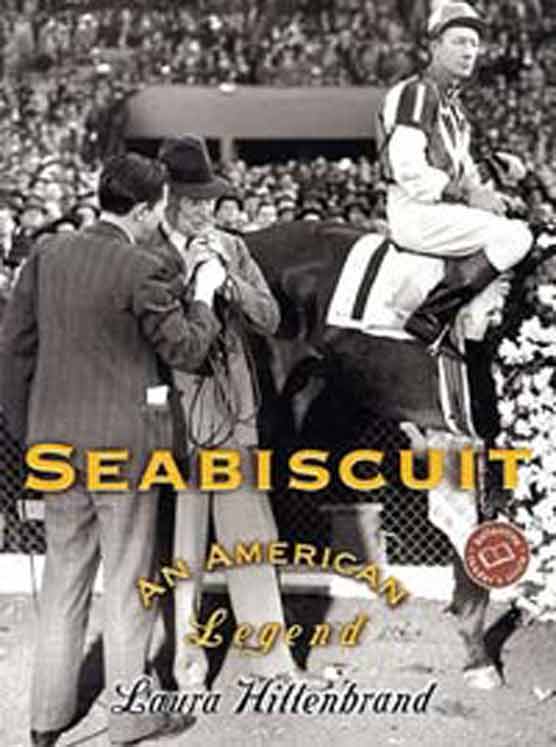|
|
||
Seabiscuit Racing Bronze Statue Santa Anita |
||
|
Your Custom Commission Bronze Statue Specialist.
|
||
|
|
||
|
Early daysSeabiscuit was born from the mare Swing On and sired by Hard Tack (son of Man O' War). The son was named for the father; the word "seabiscuit" is a synonym for a type of cracker known as "hardtack". The bay colt grew up on Claiborne Farm in Paris, Kentucky. He was undersized, knobby-kneed, and not much to look at, and was given to sleeping and eating for long periods. Initially he was trained by the legendary Sunny Jim Fitzsimmons, who had taken Gallant Fox to the United States Triple Crown of Thoroughbred Racing. Fitzsimmons saw some potential in Seabiscuit, but felt the horse was lazy, and with most of his time taken training Omaha (another Triple Crown winner), Seabiscuit was relegated to a punishing schedule of small races. In his first ten races he failed to win, and most times finished well back of the field. After that, training him for racing was almost an afterthought and the horse was sometimes the butt of jokes. Then, as a three-year-old, Seabiscuit raced thirty-five times, coming in first five times and running second seven times. Still, at the end of the racing season, he was used as a work horse. The next racing season, the colt was again less than spectacular and his owners unloaded the horse for $2,000, to automobile entrepreneur Charles S. Howard. 
His new trainer, Tom Smith, understood the horse and his unorthodox training methods gradually raised Seabiscuit from his lethargy. Smith paired the horse with Canadian jockey Red Pollard (1909-1981), who had experience racing in the West and in Mexico, but was now down on his luck. On August 22, 1936 Seabiscuit raced for the first time for his new jockey and trainer, in Detroit, without impressing. But improvements came quickly and in their remaining eight races in the East, Seabiscuit and Pollard won several times, including Detroit's Governor's Handicap (worth $5,600) and the Scarsdale Handicap (worth $7,300). In early November 1936, Howard and Smith shipped the horse to California in a rail car. His last two races of the year were at Bay Meadows racetrack in San Mateo, California (just south of San Francisco), and gave some clue as to what was to come. The first was the $2,700 Bay Bridge Handicap, run over one mile (1.6 km). Seabiscuit started badly from the stalls, but, despite carrying the top weight of 116 lb (53 kg), ran through the field before easing up to win by five lengths, in a time only two fifths of a second outside the world record. This form was carried over to the World's Fair Handicap (Bay Meadows' most prestigious stakes race) with Seabiscuit leading throughout, to win by a distance. For 1937, Howard and Smith turned their attention to February's Santa Anita Handicap. The race, California's most prestigious, was worth over $125,000 (over $1.5 million in 2006 dollars) to the winner and was known colloquially as "The Hundred Grander". In their first warm up race at Santa Anita Park, they again won easily. In his second race of 1937 (the San Antonio Handicap), Seabiscuit suffered a setback. Bumped at the start and then pushed wide, the horse trailed in fifth, with the win going to the highly-fancied Rosemont. The two would be rematched in the Hundred Grander just a week later. After half a mile (800 m), front runner Special Agent was clearly tired and Seabiscuit seemed perfectly placed to capitalise, before inexplicably slowing on the final straight. The fast closing Rosemont took his chance, edging out Seabiscuit by a nose. The defeat was devastating to Smith and Howard, and widely attributed in the press to a riding error. Pollard, who had seemingly not seen Rosemont over his shoulder until too late, had lost the sight in one eye in an accident during a training ride (not during a boxing match as implied in the 2003 film), a fact he hid throughout his career. Regardless, the horse was rapidly becoming a favorite among California racing fans, and his fame spread as he won his next three races, before Howard chose to again relocate the horse, this time for the more prestigious Eastern racing circuit. Once there, Seabiscuit's run of victories continued unabated. Between June 26 and August 7, he ran five times, each time a stakes race, and each time he won, despite steadily increasing imposts of up to 130 lb (59 kg). The seven consecutive stakes victories tied the record. On September 11, Smith accepted an impost of 132 lb (60 kg) for the Narragansett Special. On race day, the ground was slow and heavy, and entirely unsuited to the Biscuit, even without the heaviest burden of his career. Smith wished to scratch, but Howard overruled him. Seabiscuit was never in the running, and trudged home in third, four lengths behind Calumet Dick, who was carrying only 115 lb (52 kg). The streak was snapped, but the season was not over. Seabiscuit won his next three races (one a dead heat) before finishing the year with a valiant second place at Pimlico. In 1937, Seabiscuit won eleven of his fifteen races and was the leading money winner in the United States that year. On the West Coast, he had risen to the status of celebrity. His races were followed fanatically on the radio and newsreel and filled hundreds of column inches in the newspapers. Howard, with his business acumen, was ready to cash in, marketing a full range of merchandise to the fans. Considerably less impressed was the Eastern racing establishment. The great three-year-old, War Admiral, had won the Triple Crown that season and was voted the most prestigious honor, the Eclipse Award for Horse of the Year.
|
||
|
|
||
| Copyright all rights reserved 2005-15 ICONStatues.com © | ||